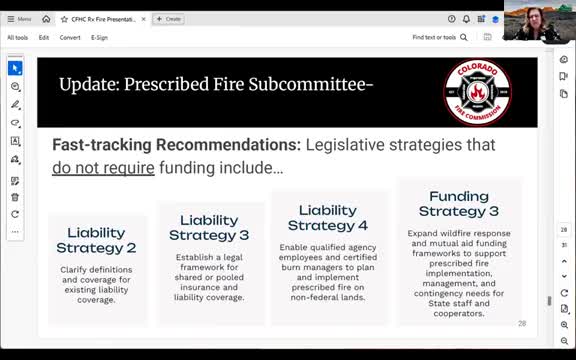Colorado's Prescribed Burn Associations Face Barriers as Rural Needs Emerge
August 07, 2025 | Department of Personnel & Administration, State Agencies, Organizations, Executive, Colorado
Thanks to Scribe from Workplace AI , all articles about Colorado are free for you to enjoy throughout 2025!

This article was created by AI using a video recording of the meeting. It summarizes the key points discussed, but for full details and context, please refer to the video of the full meeting. Link to Full Meeting
The council members expressed a collective curiosity about why prescribed burn associations are not more common in Colorado. One participant pointed out that initial recommendations to investigate this issue had seemingly fallen by the wayside, leaving many questions unanswered. “Why aren’t they happening, and are there barriers?” they pondered, suggesting that liability concerns might be a significant factor.
As the conversation unfolded, it became clear that the absence of these associations could hinder effective fire management across the state. Members emphasized the need for a tailored approach, particularly for rural communities, where existing regulations may not align with local practices. One commissioner passionately advocated for the importance of considering rural Colorado's unique circumstances, warning against overreach that could impose unnecessary regulations on smaller counties.
The dialogue also touched on the potential of pile burning as a practical solution. Mark Morgan, participating via Zoom, suggested that increasing pile burning activities could help build public confidence in prescribed burns. “You have to have a track record that you can do this,” he stated, emphasizing that successful pile burning could serve as a stepping stone toward broader acceptance of prescribed burns.
The council recognized that while the U.S. Forest Service maintains jurisdiction over federal lands, the focus of their discussions was on non-federal lands, particularly private properties. This distinction is crucial, as many homeowners currently navigate a patchwork of regulations that can complicate their ability to conduct controlled burns.
As the meeting drew to a close, the overarching sentiment was clear: there is a pressing need for a more cohesive strategy regarding prescribed burns in Colorado. The council members left with a renewed commitment to explore the barriers to establishing prescribed burn associations and to advocate for legislative changes that would better support local fire management efforts. The future of Colorado's forests may depend on these discussions, as the state grapples with the dual challenges of wildfire risk and forest health.
Converted from April 30, 2025 Colorado Forest Health Council Meeting meeting on August 07, 2025
Link to Full Meeting
Comments
View full meeting
This article is based on a recent meeting—watch the full video and explore the complete transcript for deeper insights into the discussion.
View full meeting
